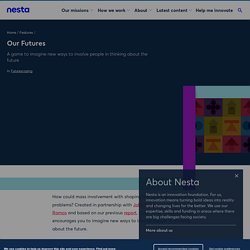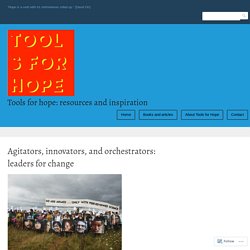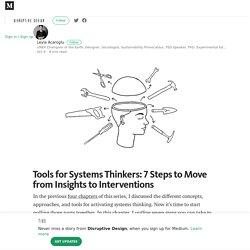

(78) Ten lessons from developing a strategic radar for horizon scanning. The first five minutes of the future. Visual tour through the technology hype cycle. 10 Types of Innovation: The Art of Discovering a Breakthrough Product. As venture capitalist Peter Thiel once put it, “competition is for losers”.

It’s inevitable that every company must be out there battling for market share, but you don’t really want to be in a situation where the competition is so stiff that any potential upside is eroded away in the process—―a scenario known as perfect competition in economics. To avoid perfect competition, companies must strive to build an economic moat that gives them a sustainable competitive advantage over time. Our Futures. How could mass involvement with shaping the future solve complex problems?

Created in partnership with John Sweeney and Jose Ramos and based on our previous report, Our Futures is a game that encourages you to imagine new ways to involve people in thinking about the future. 21st century challenges cannot be addressed using 20th century mindsets and traditional models of public engagement – Our Futures, is meant to inspire and provoke new, and sometimes unusual, ways to unlock public imagination about alternative futures.
Key questions you'll ask throughout the game include – how might emerging technologies be used in combination with participatory futures approaches and how might they help us find new ways to involve citizens in tackling 21st century challenges? Platforms for Shared Work Online. Strategic Intelligence. Tips for Using Zoom: How to Become a Videoconference Power User. How to Keep Your Zoom Chats Private and Secure. A Crash Course in Translating Your Process to a Virtual Setting. Your meeting room is all prepared.

Your templates, markers, and sticky notes are at hand. But you and your client are both (very properly) practicing social distancing. So you have a face-to-face process for [strategy, visioning, brainstorming, decision-making, you name it], and you suddenly need to deliver this session remotely. Our futures by the people for the people HrqsGPo. The Polak Game: an exercise to help reveal your theories of the future. Dutch sociologist and Holocaust survivor Frederik Lodewijk Polak's massive future studies text The Image of the Future makes a bold statement about optimism and pessimism, creating four categories of belief about the future, divided on two axes: things are improving/worsening; and people can/can't do something about the future.

From this taxonomy, Peter Hayward from Swinburne University created the "Polak Game," played in workshops to help participants clarify their views about the future and where those views stem from, and what those points of view erases, and what they elevate. The game was picked up by CMU's Stuart Candy, and spread to many other contexts, mutating as it went, becoming a favorite at places like the Institute for the Future (Jane McGonigal and Mark wrote about it in this IFTF report). In a joint paper for the Journal of Future Studies, Hayward and Candy describe the game's inception, uses, history and lessons. The Polak Game, Or: Where Do You Stand? (via 4 Short Links) Nike and Boeing Are Paying Sci-Fi Writers to Predict Their Futures. The headquarters of SciFuture, another central player in this nascent industry, sits just above the Psychic Eye Occult Bookshop, on the second floor of a small business complex on Ventura Boulevard that smells slightly of incense.

The company’s office is mostly one large, open, naturally lit room and a small bookshelf, where Neal Stephenson titles line the top row. Ari Popper, CEO of SciFuture, is thin and unimposing, with an easy smile and an undercurrent of nervous energy. He grins as I come up the stairs. McKinsey’s Three Horizons Model Defined Innovation for Years. Here’s Why It No Longer Applies. The Futures Cone, use and history – The Voroscope. From time to time people ask me about the Futures Cone, and how it came about.

Let me give a brief history of how I came across it before adapting it to suit my use of the concept. I first began using the Futures Cone diagram in 2000 when working as a foresight analyst for Swinburne University (before becoming an academic in the Master of Strategic Foresight). The text in this post is excerpted from a chapter I recently submitted to the upcoming Handbook of Anticipation, ed.
Roberto Poli (Springer International). Agitators, innovators, and orchestrators: leaders for change – Tools for hope: resources and inspiration. Image: Agitators at work at Heathrow Airport.

Andrew Curry writes: I was struck by an article in Stanford Social Innovation Review that argued that it takes three types of leaders to make social innovation happen: the agitator, the innovator, and the orchestrator: An agitator brings the grievances of specific individuals or groups to the forefront of public awareness. An innovator creates an actionable solution to address these grievances.
The landscape of innovation approaches: We've mapped various innovation methods from our years of work with innovation experts, lab practitioners & colleagues #psilabs. E-book Strategic Narrative.pdf. Futures Thinking Playbook by Julia Rose West. WVS Database. How technology has changed over the last three decades - Washington Post.
“Hope is a verb with its shirtsleeves rolled up.” (David Orr) – Resources from the APF Tools for Hope ProDev day, London. Tools for Systems Thinkers: 7 Steps to Move from Insights to Interventions. In the previous four chapters of this series, I discussed the different concepts, approaches, and tools for activating systems thinking.

Now it’s time to start pulling those parts together. In this chapter, I outline seven steps you can take to move from systems exploration to a practice of systems interventions*. An overview of foresight methods. Scanning the Periphery. Between 2001 and 2004, Mattel lost 20% of its share of the worldwide fashion-doll segment to smaller rivals such as MGA Entertainment, creator of a hip new line of dolls called Bratz.

MGA recognized what Mattel had failed to—that preteen girls were becoming more sophisticated and maturing more quickly. At younger ages, they were outgrowing Barbie and increasingly preferring dolls that looked like their teenage siblings and the pop stars they idolized. As the target market for Barbie narrowed from girls ages three to 11 to girls about three to five, the Bratz line cut rapidly into the seemingly unassailable Mattel franchise. Mattel finally moved to rescue Barbie’s declining fortunes, launching a brand extension called My Scene that targeted older girls, and a line of hip dolls called Flavas to compete head-on with Bratz.
But the damage was done. As this article shows, improving peripheral vision begins by asking the right questions. Defining Scope Asking the Right Questions. The Three Horizons of innovation and culture change. In the autumn of 2009, I was invited to join the International Futures Forum (IFF) as one of a small group of ‘next generation’ members.

The IFF is an international collaborative network of people committed to pooling their experience and insights to explore “the complex and confounding challenges that our world faces”, to “support a transformative response to those challenges” and to “enhance our capacity for effective action”. One common perspective shared between the members of the IFF is that we need a more systemic approach to the complexity of the interconnected problems and opportunities that we face. Another shared belief is that, in order to appropriately respond to the changes around us, organizations, communities, businesses and governments must not only pay attention to possible short-term responses to symptoms of these crises, but must also address the underlying structural and systemic causes that drive these symptoms. A Field Guide to Ethnographic Experiential Futures: @kellykornet and I just presented/released version 1.0 today in Brussels at #DDT #ATFI. Are You Solving the Right Problems?
How good is your company at problem solving? Probably quite good, if your managers are like those at the companies I’ve studied. What they struggle with, it turns out, is not solving problems but figuring out what the problems are. In surveys of 106 C-suite executives who represented 91 private and public-sector companies in 17 countries, I found that a full 85% strongly agreed or agreed that their organizations were bad at problem diagnosis, and 87% strongly agreed or agreed that this flaw carried significant costs. Short Description of Three Tools Used in Foresight. Assembling a Futures / Foresight Toolkit – Wendy L Schultz – Medium. Extreme uncertainty making you uneasy? Want to pivot from challenge to opportunity on the fulcrum of emerging change? It’s probably time for a skills update. First you may want to find out the full range of what’s on offer to supercharge your futures thinking. People new to futures research and foresight often think that scenario planning is the be all and end all of foresight.
But there are at least six key activities in well-designed futures research, and dozens of tools available for each activity — and they all can be interconnected, intermixed, and layered. Login - Dropbox. iMODELER. Mental Modeler - Fuzzy Logic Cognitive Mapping. The Augur beta test has begun! – The Augur Report. Is scenario planning back in vogue - Enterprise Times.
Kinaxis and Deloitte Consulting LLP have announced an alliance to develop scenario planning capabilities for business supply chains. The alliance is intended to create “what if” scenarios for large enterprise customers, so that they can make informed decisions and develop their end-to-end supply chains. The intention is to develop the capability in their clients to meet the demand of rapid market changes in real-time. This is the second announcement about supply chain scenario planning that we have covered in recent weeks. Plex announced enhancements to their supply chain solution to introduce scenario planning capability within their software.
Appreciative Inquiry and the Power of Negative Thinking - InSpiral Pathways. Future Perspective Understanding Best Practice in Strategic Futures work 2011. Strategic Futures. Design Thinking Action Lab. Rethinking the received wisdom on ‘foresight’ practices. Early in my PhD studies I reviewed the literature on so-called ‘foresight’ practices such as on scenario-building, scenario-based planning, and techno-economic modelling. What came through clearly is that there is a dominant set of ideas about these practices.
These ideas can be termed the received wisdom. Scenarios: Shooting the Rapids. I recently discussed scenario analysis with a well-known futurist. Overcoming obstacles to effective scenario planning. When scenario planning has worked well, it has proved enormously useful to a wide range of organizations as a tool for making decisions under uncertainty. First popularized by Shell in the early 1970s, the approach should be a natural complement to other ways of developing strategy—especially when executives are as concerned about geopolitical dynamics as many are today. It would probably be more widely used if it hadn’t been such a disappointment to many executives.
In fact, 40 percent of those we surveyed in 2013 described it as having little effectiveness. How to See the Future First. IRI 2038 Futures Study. Launch Date: May 2012 Wrap-up Date: November 2013. Future_fabulators:new_approaches_and_needs_in_foresight [the libarynth] Association of Professional Futurists - “Warming up your brain” using the Theory of Inventive Problem Solving. Futures toolkit for policy-makers and analysts. HSC Toolkit - The tools. Future_fabulators:new_approaches_and_needs_in_foresight [the libarynth]
The Art of Data Visualization: How to Tell Complex Stories Through Smart Design. SCAN and Causal Layered Analysis. The Thing From The Future – Situation Lab - OCADU. The Life Cycle Of Ideas. How to see into the future. Foresight is the Secret Weapon of Success. Three Horizons – fields of future, full of foresight. Methods.